
The Portland Bureau of Transportation announced Thursday they will break ground on a project to improve bus and bike access on Southwest Jefferson street in the Goose Hollow area. The project is part of PBOT’s Central City in Motion plan and was first expected to begin last year.
In a statement yesterday, the city said the project will “relieve a major pinch point in the transit system” and “improve transit speed and reliability for five TriMet bus lines (6, 45, 55, 58, 68) by adding a new bus-and-turn (BAT) lane on the south side of SW Jefferson Street between SW 16th and 18th avenues. A new protected bike lane will also be added as part of the project to improve safety for people bicycling.” In addition to changes to the bus and bike lanes, PBOT will build a new concrete bus island on the southeast corner of Jefferson and 17th.
“This is an investment in making transit faster and more reliable for people who live and work in Goose Hollow,” and “will benefit people riding the bus, driving, biking, and businesses overall,” said PBOT Interim Director Tara Wasiak. Other benefits of the project laid out by Wasiak include fewer backups for drivers looking to get onto Highway 26 and a safer bike lane. “All modes of travel will have improved access to businesses in the area,” she said.
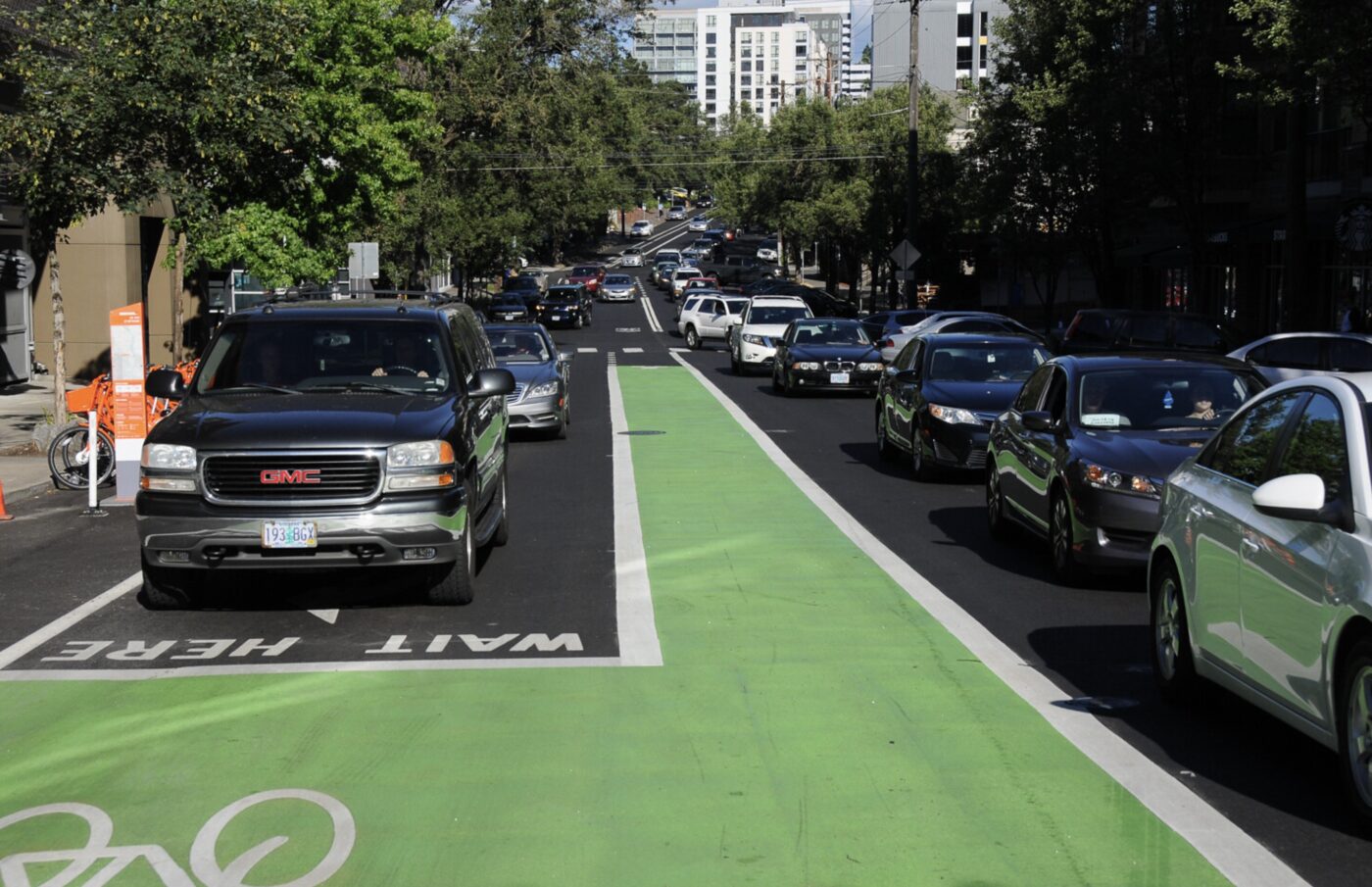

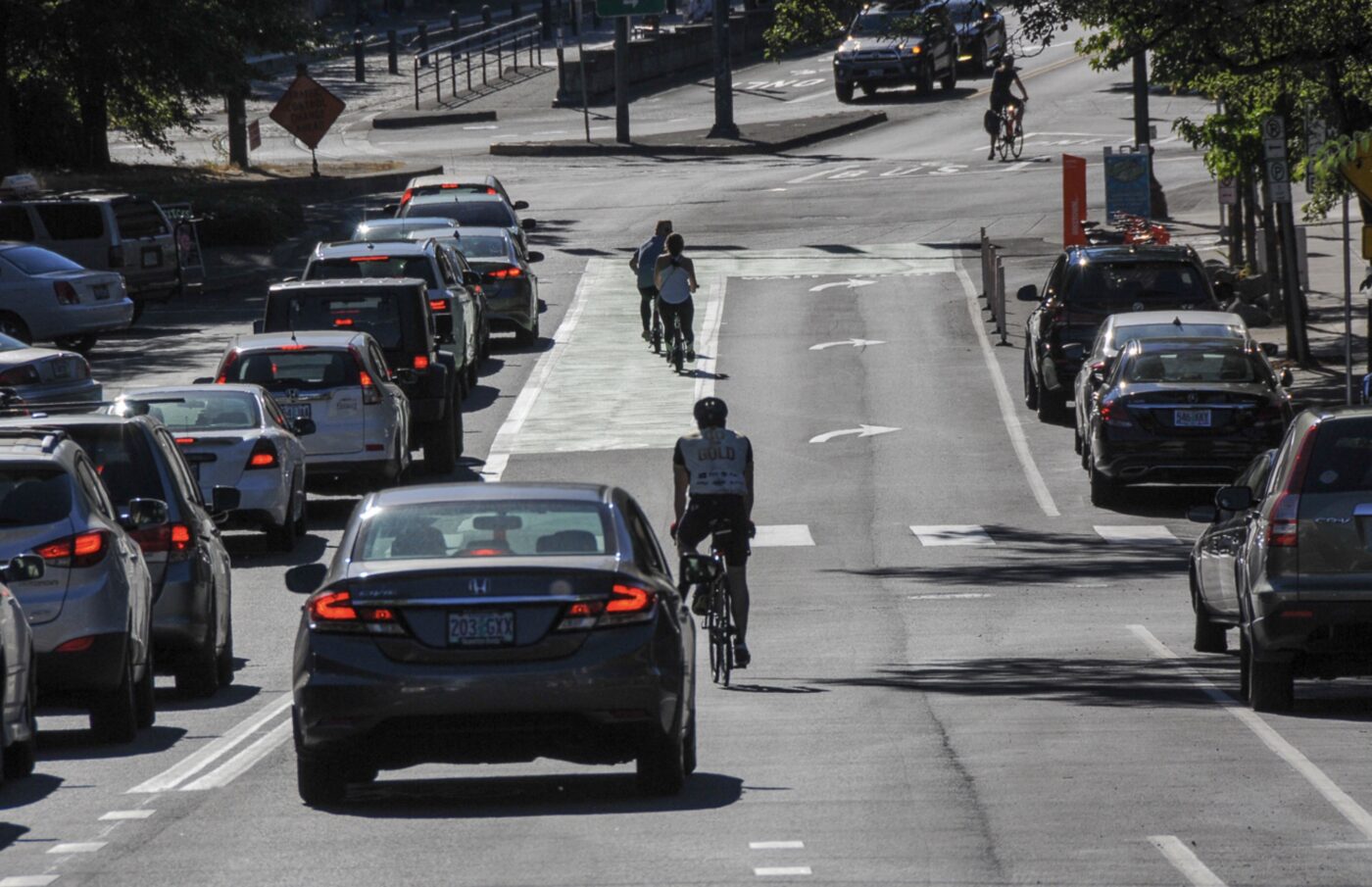
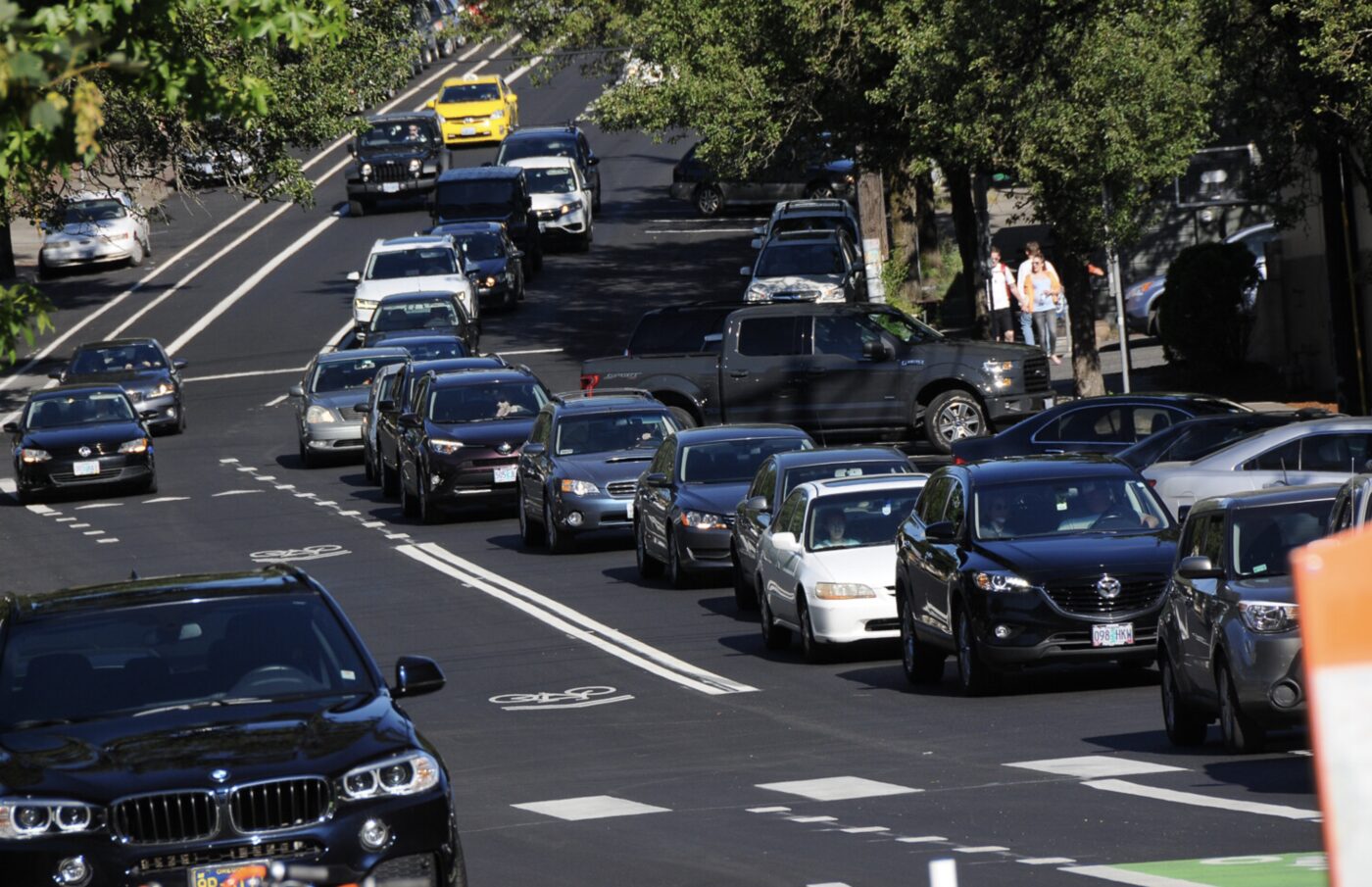
With this project, PBOT will not only get to tick another CCIM project off their list, they’ll also be able to fix what Mayor Ted Wheeler felt was a big mistake when they restriped this same section of road in 2018. At a city council meeting in July of that year, Wheeler (and his late colleague Commissioner Nick Fish) piped up to make several pointed complaints about the current configuration. Fish said PBOT “over-engineered” the street and Wheeler added that the new striping had, “made the biking situation worse.” “I’m not convinced we made it better. We made it worse and I’m curious what problem it was we were trying to solve here,” Wheeler said.
Fish and Wheeler had reasonable point. The current configuration between 16th and 18th goes from bike lane, to (sharrowed) mixing zone, and then to a center-running green bike lane in the span of just two blocks. The new plan will make the cycling experience much more consistent with a continuous, curbside bike lane protected from other lanes with plastic delineator wands. And instead of a bike box at 18th, the new design will maintain the bike lane at the curb and push back the stop line for drivers who want to turn right onto 18th. Drivers will also have a more legible environment to operate in, and should find using Jefferson to go west and get onto Highway 26 to be easier and less congested.
What’s really good to see in this project is what appears to be a dramatic reduction in on-street car parking. PBOT will remove two blocks of parallel parking spaces (about 20 by my count) on the north side of Jefferson to make room for the bike lane. And on the south side of the street, it looks like the total number of available car parking spaces will be reduced from 23 spaces to 11.
Construction is anticipated to begin May 8th, and should last about two months. This is just the first phase of PBOT’s CCIM project on SW Jefferson. They plan to make changes to bus and bike lanes from 16th east to Naito Parkway in future phases.


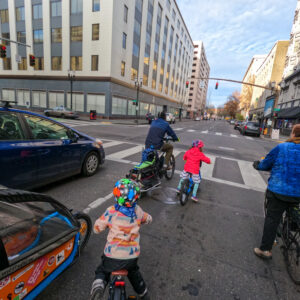
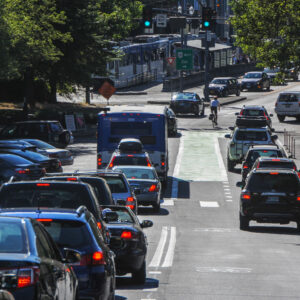

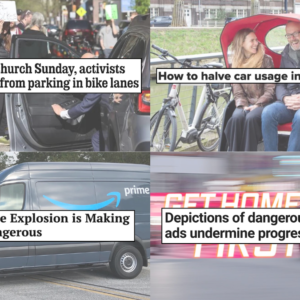
Thanks for reading.
BikePortland has served this community with independent community journalism since 2005. We rely on subscriptions from readers like you to survive. Your financial support is vital in keeping this valuable resource alive and well.
Please subscribe today to strengthen and expand our work.
Looks nice, definitely an improvement for cycling (though I’d obviously prefer concrete to plastic knock-down wands). For transit, I always get a bit bummed when streets with multiple lanes for cars have right turns allowed in the bus lane. Surely the well trained and licensed drivers of Portland could manage looking out for a bus while turning right (or be protected by a signal?).
Like looking at the NATCO transit intersection guide, it’s frustrating to see that there are no clear recommendations for just bus lanes that go through the whole intersection. It’s also annoying to see that every single street has curbside parking by default – as if it’s just so obvious that the curb is for parking personal vehicles and nothing else. Sigh.
“What’s really good to see in this project is what appears to be a dramatic reduction in on-street car parking. PBOT will remove two blocks of parallel parking spaces (about 20 by my count) “
Jonathan do you want less parking or better bike lanes? Gloating about less parking is NOT going to help your cause with the majority of Portlanders. We need wide buy in to improve our bikeshare. The Bike Loud, Street Trust radicalism approach isn’t working.
If you look at the history of how the Netherlands successfully changed their streetscape you will see it came from a groundswell of popular support, not embracing a few radical extremists.
Let’s focus on the benefits of biking for ALL in Portland. It’s needs to be welcoming, safe and clean to get those on the sidelines to join in.
Hi Randi J,
I don’t think saying it’s good that we will have less car parking is “gloating” but the fact that you hear it that way is very telling. It’s a fact that on-street car parking is not a good use of public space. That’s not radical at all. What I think is radical and extreme is that so many Americans are convinced otherwise.
And I’m not here to be a part of any “cause.” I’m just doing my job which is to document, report, and share my opinion. Please don’t lump me or BP into any other groups. We are a 100% independent entity.
And your comparison to the Netherlands is interesting. They had some very radical factions that made that movement work (kindermoord, velo provo, little old ladies standing in front of cars, etc…). I believe radicalism is essential to moving the needle when the status quo power structure is so dominant. I won’t water down my opinions in hopes that “the other side” will approve of them or feel less threatened. I am the other side! I own two cars and park downtown too sometimes!
Thanks for trying to police my tone. But it won’t work.
Yeah…anarchists, greens, and socialists that fought in the streets to eliminate cars and parking spaces from urban centers. Given that the USA has never really had a left wing of any consequence I’m not surprised that you would dismiss the idea that leftism might be popular elsewhere.
those parking spots have caused some near misses for me while cycling, and I am to se them removed. If the City has to choose between safety and transit or parking, I think it should be an easy decision to dump parking. I rode down Flanders this week and was struck by how many conflicts the parking caused- I wish PBOT would have removed more parking along this greenway.
It’s pretty simple, actually. Less parking = better bike lanes.
I’m not opposed but if you want to sell that to the general public (and get MORE & BETTER bike lanes) you need to focus on how great protected/excellent bike lanes are and not shout gleefully about how much parking was removed.
1) This article has nothing to do with selling anything to the general public.
2) This article DOES focus on how much better the bike lanes will be. The part about removing parking is just a sentence or two.
3) Unwillingness to remove on-street parking spaces is probably the most common reason street improvement projects are compromised. Removing parking means more room/options for bike lanes, wider sidewalks, more trees, less paving, even more traffic lanes if that’s desirable. So often with its improvement projects, PBOT has chosen to prioritize parking over any of those other alternatives. There’s nothing wrong about being “gleeful” that on this project PBOT chose a use other than parking for that area of the street.
This critique would be more relevant if there weren’t two parking lots 100 ft away. This is an improvement for this stretch of Jefferson, and the loss of a few on-street spots (which local businesses were consulted about) is nothing to get worked up about in my opinion.
Here’s a great example of how prior efforts to assist in pedestrianizing restrains safe design in the present. Curb cutouts are great IF they are not used as obstructions to future designs such as PBLs. This was used as evidence against PBLs on Hawthorne, for example. So instead of a physically protected bike lane that is separated at the intersection (which is the purpose of a PBL), there is a narrow “protected” bike lane adjacent to traffic. Here’s why this is bad if it’s not already apparent.
http://www.protectedintersection.com/
A basic protected intersection design wouldn’t be more expensive, nor would it be more difficult to implement. Planters suffice. The use of curb cuts are great, except when they are used to preclude safe design.
Considering how severely impacted Trimet line 14 has been by the two-lane reduction on Hawthorne (despite many cycling advocates falsely claiming the street would have higher speeds and throughput) I don’t know how anyone could still be arguing for PBL on Hawthorne. A shared bike-bus lane, sure, but in the face of the disastrous reduction in transit efficiency on Hawthorne this pining for PBLs is like rubbing salt in transit riders wounds.
You’re assuming SOV traffic can/should never be limited. PBLs and intersections limited to delivery and buses would easily allow this. For example, at 12th limit eastbound traffic to buses and delivery vehicles. Pitting people who ride transit against people walking vs people biking ignores the actual problem: the almost limitless and unrestricted access of SOVs to nearly every street in Portland. That is a problem easily solved by traffic diversion. Traffic diversion would increase the speed/frequency of buses on the corridor as well as make it safer for people walking and biking.
This looks like an improvement. I have had some uncomfortable moments trying to merge out of the bike lane while people driving are trying to decide whether or not to park, turn right, or gun it to catch the light.
Some provisions on Columbia and 18th would make Goose Hollow so much more accessible! All of Goose Hollow gets a lot of abuse from navigation apps as a rat-run around freeway jams, which combined with topography creates a critical need for a properly provisioned bike routes in all four directions. Jefferson is awesome, but how do you get back from Goose Hollow once you get there on Jefferson? Salmon is technically suggested as a bike route, but the rotten pavement, school traffic, and no bike provisions make it the most unpleasant route available. 18th is painfully missing provisions that connect to the 18th/19th infrastructure. Alder only properly connects from 19th to the north. Add Columbia and 18th to the mix and bicycling to and from Goose Hollow would be vastly improved.
Yes, good question – how do I get OUT of Goose Hollow, especially if I want to go north? The school cuts off 15, 16, and 17th, I think. Last time I ended up riding up 18th, and was just lucky I didn’t back up cars behind me. (I walked my bike up onto the sidewalk when I got caught by a light to wait until the cars cleared.) Columbia all the way down to 14th, then north does not look very bike friendly, especially before Jefferson.
I don’t see how to fix 18th. Maybe best to just take the Max when I need to go to the area or walk my bike on the sidewalk…..
20th is a decent route…if you’re willing and able to climb that hill.
But I also know that there’s a big development project going on at what used to be the Lincoln High School field. Does anyone know if they are going to reconnect 17th? A look at Google Maps suggests they might be adding a car-free path through there. If so, then that would be a great route.
You’re allowed to pass thru 17th outside of school hours. There’s a gate, but it’s unlocked. Not convenient to bike, but definitely convenient on foot.